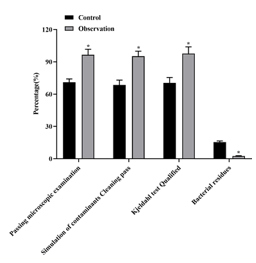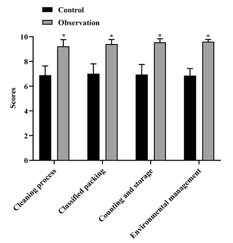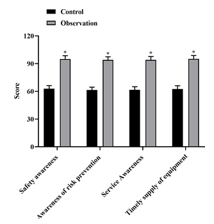Research Article
An Analysis of The Disinfection Supply Center's Management of Surgical Reuse Tool Cleaning as It Relates to Continuous Quality Improvement
- Muhammad Waqar Mazhar *
Department of Bioinformatics and Biotechnology, Government College University, 38000, Faisalabad, Pakistan.
*Corresponding Author: Muhammad Waqar Mazhar, Department of Bioinformatics and Biotechnology, Government College University, 38000, Faisalabad, Pakistan.
Citation: Muhammad W. Mazhar. (2025). An Analysis of The Disinfection Supply Center's Management of Surgical Reuse Tool Cleaning as It Relates to Continuous Quality Improvement, Journal of BioMed Research and Reports, BioRes Scientia Publishers. 7(3):1-6. DOI: 10.59657/2837-4681.brs.25.134
Copyright: © 2025 Muhammad Waqar Mazhar, this is an open-access article distributed under the terms of the Creative Commons Attribution License, which permits unrestricted use, distribution, and reproduction in any medium, provided the original author and source are credited.
Received: January 21, 2025 | Accepted: February 05, 2025 | Published: February 14, 2025
Abstract
Objective: The purpose of this study is to examine how well surgical reuse tool cleaning is managed through continuous quality improvement.
Methods: There were a thousand surgical tools that were cleaned and disinfected at our hospital's disinfection supply center between 2020 and 2022. Of them, 500 were randomly assigned to the observation group (OG) and 500 to the control group (CG). The CG was managed on a normal basis, whereas the OG was introduced with specific interventions. A comparison was made between the two groups with respect to the following measures: nursing management quality, cleaning effect, satisfaction with instrument cleaning and disinfection effect, instrument consumption, and adverse events of surgical tool packing.
Results: Compared to the CG, the OG had a lower incidence of surgical instrument injury (P<0.05). Compared to the CG, the OG had a lower overall incidence of adverse events related to surgical equipment packing (P<0.05). Compared to the CG, the OG had an increased qualifying rate of instrument microscopy, simulated pollutant cleaning, and Kjeldahl test, and a decreased bacterial residue rate (P<0.05). Compared to CG, OG reported higher levels of satisfaction with instrument usage (P<0.05). Environmental management quality, inventory storage, categorization packing, and cleaning process all showed an increase in OG as compared to CG (P<0.05). In comparison to the CG, the OG had higher scores in safety awareness, risk awareness, service awareness, and timely equipment provision (P<0.05).
Conclusion: Surgical mechanical cleaning, adverse event and instrument damage rates, physician satisfaction, and instrument management can all be greatly enhanced with the use of continuous quality improvement management. This makes it a worthy clinical reference for improving surgical procedures.
Keywords: disinfection supply center; surgical reuse instrument; clean management; continuous quality improvement
Introduction
Cleaning and disinfecting the hospital's equipment and surroundings is a crucial function of the disinfection supply center [1]. The life safety of patients is closely related to the quality of disinfection. The disinfection supply center is playing an increasingly essential role in hospitals due to the development of medical technology. It is a critical department for controlling and preventing nosocomial infections [2]. A major factor in limiting the spread of nosocomial infections is the regular cleaning and disinfection of hospital equipment. More people will pay attention to medical conflicts now that people's legal knowledge has increased. The importance of a well-controlled disinfection supply center for hospitals cannot be overstated, as medical conflicts resulting from cross-contamination of medical equipment are rather prevalent. An all-encompassing and thorough intervention provides finer-grained control over each and every link in the disinfection supply chain [3]. In order to accomplish the goal of continuously improving the quality of work, one quality management mode called continuous quality improvement (CQI) analyzes the current situation, sets objectives, finds and solves problems, and evaluates the effect. CQI is based on total quality management [4]. The researchers set out to find out how CQI affects the management of cleaning for reusable surgical tools.
Data and Methods
General Data
There were a thousand surgical tools that were cleaned and disinfected at our hospital's disinfection supply center between 2020 and 2022. Of them, 500 were randomly assigned to the observation group (OG) and 500 to the control group (CG). The CG contains a variety of items, including 130 surgical blades, 102 surgical scissors, 68 surgical forceps, 80 surgical tweezers, 53 uterine suction tubes, 47 sterilizing bowls, and 20 speculums. Within the observation group, there were various devices such as 128 surgical knives, 104 surgical scissors, 70 surgical forceps, 76 surgical tweezers, 51 uterine suction tubes, 50 sterilizing bowls, and 19 speculums. Because there was no statistically significant difference (P>0.05), we may say that the two groups are comparable. The hospital's Perception Committee examined the research and gave its approval.
Methods
The nursing staff sterilized and disinfected the surgical tools in accordance with the operation standards provided by the disinfection supply center when the CG was under normal maintenance. In order to put the OG into action, certain interventions were carried out. These included enhancing service and safety awareness and strengthening the required operating training of nursing personnel. In order for the nursing staff at the disinfection supply center to be able to identify mistakes and review them promptly, it is important to establish a reasonable system of grouping, create an evaluation system, conduct group management, summarize the situation weekly, and apply rewards and punishments. Staff at disinfection supply centers should have better training, relevant workers should undergo thorough process implementation, and the working process should be executed in detail. More emphasis on uniform treatment should be placed on the work flow. Once the medical tools have been disinfected, they are immediately dried and packed. Transport vans and recovery vehicles are clearly marked to avoid any mistake as they deliver the bundled instruments to the appropriate departments. It is important to maintain control over the disinfection and supply center's environment and functional area, and to disinfect and purify the air in the facility on a daily basis. The appropriate staff will be able to disassemble the equipment and become experts in cleaning if a professional map is prepared. Label the device with its name and model, carefully note the features and needs of each link, compile all the essential information into a handbook, and then distribute it to the appropriate individuals for easy learning and searching. Everyone has to make sure they're keeping track of their daily tasks, raise any questions or concerns promptly, and then use group discussion to figure out how to fix the issues that have arisen. During the regularly scheduled quality analysis team meetings, the issues pertaining to the most recent tasks should be reviewed, after which the root causes should be investigated, fixes should be implemented, and the process should be further optimized.
Observation Indicators
- Nursing quality score in management. A questionnaire survey was used to assess the nursing staff's knowledge of risks, safety, service, and equipment supply timeliness as part of the nursing management quality score. Each item had a maximum possible score of 100 points; a higher score indicated better nurse management.
- The two sets of equipment were detected using an adenosine triphosphate (ATP) biofluorescence detector, and their cleaning and disinfection effects were contrasted. The main components of the qualified rate were the following: the equipment microscopic inspection rate, the simulated pollutant cleaning rate, the Jellet test rate (where an ATP value of 45 or less was considered qualified for the light value unit), and the bacterial residue rate (where a bacterial number of less than 20 cfu/cm2 and the absence of pathogenic bacteria were considered to be absent from the sample).
- We compared the two groups based on how happy the medical professionals were with the equipment' cleanliness and disinfection after each treatment. To clarify, the disinfection supply center polled doctors and nurses via problem surveys after the cleaning and disinfection processes were complete to gauge their level of satisfaction with the results. A higher score indicated more satisfaction with the disinfection and cleaning impact of the instruments, out of a possible 100 points.
- Consumption statistics, broken or damaged oral tools, loss of function, mutilation, etc.
- We compared the two groups based on the frequency of adverse events reported with surgical equipment packing.
- The questionnaire survey was used to assess the nursing staff's understanding of safety, risks, services, and timely equipment delivery as part of the nursing management quality score. Every item had a total possible score of 100. The better the nurse management, the higher the score.
Statistical Analysis
The statistical analysis was conducted using SPSS20.0 program. Measurement data was analyzed using a t-test, whereas counting data was analyzed using a χ2 test. Statistical significance was determined when P less than 0.05.
Results
Comparison of the Occurrence of Surgical Instrument Injury Between the Two Groups
Table 1 shows that there was a decrease in surgical instrument damage in the OG group as compared to the CG group (P less than 0.05).
Table 1: Incidence of surgical instrument injury in the two groups.
| Groups | n | Crack | Loss of function | Mutilation | Breakage | Total |
| Observation Group | 500 | 4 | 3 | 5 | 2 | 14 (2.8%)* |
| Control Group | 500 | 11 | 10 | 8 | 12 | 41 (8.2%) |
Compared with the control group, * was P less than 0.05.
Comparison of the Occurrence of Adverse Events in Surgical Instrument Packaging Between the Two Groups
A decrease in the overall occurrence of adverse events related to surgical tool packing was seen in the OG group compared to the CG group (P less than 0.05), as is illustrated in Table 2.
Table 2: Incidence of adverse events of surgical instrument packaging in the two groups.
| Groups | n | Incompletely Sealed Packing | Wrong Equipment | Type of IdentificationError | Total Incidence Rate |
| Observation Group | 500 | 5 | 4 | 7 | 16(3.20%)* |
| Control Group | 500 | 13 | 15 | 32 | 60(12.00%) |
Comparison of Cleaning and Disinfection Effect Between the Two Groups
As demonstrated in Figure 1, the OG had a higher qualifying rate than the CG for endoscopic inspection, simulated pollutant cleaning, and the Kjeldahl test. On the other hand, the OG had a lower bacterial residual rate than the CG (P less than 0.05).
Figure 1: Comparison of cleaning and disinfection effect between the two groups. Compared with the control group, * was P less than 0.05
Satisfaction with the Use of The Instruments in Two Groups
Table 3 shows that OG had higher satisfaction with instrument use compared to CG (P less than 0.05).
Table 3: Satisfaction with the use of the instruments in two groups.
| Groups | n | Satisfaction | Partial Satisfaction | Dissatisfaction | Satisfaction Rate |
| Control Group | 500 | 220 (44.00) | 180 (36.00) | 100 (20.00) | 80.00 |
| Observation Group | 500 | 270(54.00) | 21(42.00) | 20 (4.00) | 96.00* |
| X2 | 6.061 | ||||
| P | 0.014 |
Comparison of the Management Quality of Surgical Instruments Between the Two Groups
The results of the cleaning process, inventory and storage, classification and packing, and environmental management quality tests in the OG were higher than in the CG (P less than 0.05), as seen in Figure 2.
Figure 2: Comparison of the management quality of surgical instruments between the two groups. Compared with the control group, * was P less than 0.05.
Comparison of Nursing Management Quality Scores Between Two Groups
Shown in Figure 3, the OG had superior scores in safety awareness, risk awareness, service awareness, and timely provision of equipment compared to the CG (P less than 0.05).
Figure 3: Comparison of nursing management quality scores between two groups. Compared with the control group, was P less than 0.05.
Discussion
Cleaning and disinfecting all of the medical equipment in the hospital as well as eliminating any potential environmental hazards are the crucial responsibilities of the disinfection supply center [5]. Controlling nosocomial infections and ensuring the proper use of medical equipment are two essential roles played by the nursing administration of disinfection supply centers [6]. Hence, the disinfection supply center's nurse administration is crucial. Each component of the supply room must be well-managed and controlled.
Traditional management has several downsides, including dispersed leadership and an absence of cohesive strategy. The disinfection supply center's details and the technical operation of personnel's details are standardized via detail management, which in turn lowers the incidence of undesirable behaviors [7]. By integrating specialized tasks and honing environmental and product management, detail management may boost disinfection job quality while decreasing the failure rate [8]. To achieve excellence through scientific management-based system and scope standardization, process control must be strictly implemented, plans and improvements must be made to each link and detail, operations must be clarified, overall efficiency must be improved, and processes must be continuously optimized and improved to ensure effective execution. This is known as continuous quality improvement. Nosocomial cross infection rates can be decreased and patient recovery times can be accelerated with the use of continuous quality improvement management, according to research [9]. Streamlined operations on management details and procedures, together with related group training, should be implemented as part of the disinfection supply center's ongoing quality improvement management methods. To help the staff better grasp the medical instruments, we focused on the decomposition and cleaning of the finer instruments, and we directed the ways of acute separation. In order to minimize medical disagreements, it is important to clarify the division of labor, handle the continuity of each connection and the efficacy of work, and formulate viable countermeasures for treatment and risk avoidance. Get the pretreatment done on time, optimize the process, and you won't have to worry about dried dirt causing cleaning problems or equipment loss. This study's findings indicated that the OG had higher qualified rates of cleaning, packaging, and sterilization of surgical instruments than the CG (P less than 0.05). This suggests that implementing continuous quality improvement management at the disinfection supply center could enhance these qualified rates and the management effect of surgical instruments. Sun et al. [10] found data that were generally in line with this conclusion. The study found that compared to the CG, the OG had a higher overall qualified rate of surgical tool cleaning (P<0>
Conclusion
It is worth noting that continuous quality improvement management has the potential to enhance surgical mechanical cleaning, decrease the incidence of adverse events and instrument damage, and contribute to better instrument management and physician satisfaction. These outcomes merit clinical reference.
References
- Islam, K., Murad, S., Zaneb, H., Shahid, M., Ali, S., et al. (2021). Effect on Quality Assurance Program and Radiation Dosimetry in ISO Certified Cancer Hospital During the First COVID-19 Wave. Pakistan Journal of Nuclear Medicine, 11(1).
Publisher | Google Scholor - Lówbúrý, É. J. L., Ayliffe, G. A. J., Geddes, A. M., Williams, J. D. (2013). Control of Hospital Infection: A Practical Handbook. Springer.
Publisher | Google Scholor - García-Dastugue, S. J., Rousseau, H. E. (2024). Supply Chain Awareness: Theoretical Development and Empirical Test in The Nonprofit Context. The International Journal of Logistics Management, 35(4):1224-1252.
Publisher | Google Scholor - Morfaw, J. N. (2009). Total Quality Management (TQM): A Model for The Sustainability of Projects and Programs in Africa. University Press of America.
Publisher | Google Scholor - Gupta, S. D., Sharma, S. K., Kumar, S. (2022). Quality Management in Health Care. In Healthcare System Management: Methods and Techniques. 339-367.
Publisher | Google Scholor - Wen, S., Ding, J. (2020). The Value of Strengthening Nursing Management in the Prevention and Control of Nosocomial Infection. Journal of Simulation, 8(6):81.
Publisher | Google Scholor - Fredricks-McKinley, L. (2021). Daily Environmental Cleaning for the Prevention of Healthcare-associated Infections: Evaluation of Predictors of Cleaning Compliance, Work System Analysis and Veteran Patient Perceptions in Acute and Long-term Care Veterans Administration Facilities. The University of Wisconsin-Madison.
Publisher | Google Scholor - Ullah, H., Uzair, M., Jan, Z., Ullah, M. (2024). Integrating Industry 4.0 Technologies in Defense Manufacturing: Challenges, Solutions, And Potential Opportunities. Array, 100358.
Publisher | Google Scholor - Davis, S. (2023). Strategies for Clinical Managers to Reduce Nosocomial Infections. Doctoral dissertation, Walden University.
Publisher | Google Scholor - Kong, Xiaoxiao. (2023). Application of New Nursing Concepts in Disinfection Supply Center and its Impact on Disinfection and Sterilization Qualification Rate. Urology Research. 1:22-27.
Publisher | Google Scholor - Ji, X., Jiang, F., Zhang, Z. (2024). Study on Infection Control and Management of Acute and Critically Ill Patients in Tuberculosis Clinic. Alternative Therapies in Health & Medicine, 30(9).
Publisher | Google Scholor - Alomrani, M. (2021). Disaster Nursing Education: A Qualitative Case Study to Determine the Key Concepts for National Education in The Kingdom of Saudi Arabia (KSA). Doctoral dissertation, University of York.
Publisher | Google Scholor - Liu, Qin. (2024). Evaluation of the Impact of Refined Quality Control Management Model on the Qualified Rate of Disinfection and Sterilization of Surgical Instruments in the Sterilization Supply Center. Journal of Clinical and Nursing Research. 8:168-173.
Publisher | Google Scholor
















